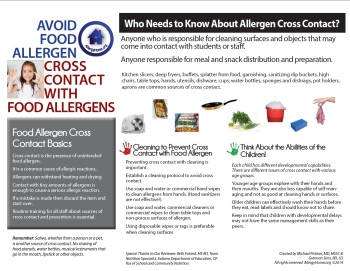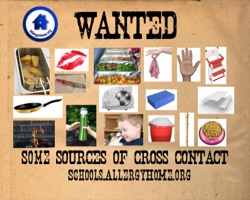Cross Contact Handout and Posters
Who Needs to Know About Allergen Cross Contact?
Created by Michael Pistiner, MD, MSSC &
Grennan Sims, RD, LD
-
Anyone who is responsible for cleaning surfaces and objects that may come into contact with students or staff.
-
Anyone responsible for meal and snack distribution and preparation.
Food Allergen Cross Contact Basics
Cross contact is the presence of unintended food allergen.
It is a common cause of allergic reactions.
Allergens can withstand heating and drying.
Contact with tiny amounts of allergens is enough to cause a serious allergic reaction.
If a mistake is made then discard the item and start over.
Routine training for all staff about sources of cross contact and prevention is essential.
Common Sources of Cross Contact
Kitchen slicers, deep fryers, buffets, splatter from food, garnishing, sanitizing dip buckets, high chairs, table tops, hands, utensils, dishware, cups, water bottles, sponges and dishrags, pot holders, aprons are common sources of cross contact.
Remember: Saliva, whether from a person or a pet, is another source of cross contact. No sharing of food,utensils, water bottles, musical instruments that go in the mouth, lipstick or other objects.
Cleaning to Prevent Cross Contact with Food Allergen
Preventing cross contact with cleaning is important.
Establish a cleaning protocol to avoid cross contact.
Use soap and water or commercial hand wipes to clean allergens from hands. (Hand sanitizers are not effective!).
Use soap and water, commercial cleaners or commercial wipes to clean table tops and non-porous surfaces of allergen.
Using disposable wipes or rags is preferable when cleaning surfaces
Think About the Abilities of the Children!
Each child has different developmental capabilities. There are different issues of cross contact with various age groups.
Younger age groups explore with their hands and their mouths. They are also less capable of self-managing and not as good at cleaning hands or surfaces.
Older children can effectively wash their hands before they eat, read labels and should know not to share.
Keep in mind that children with developmental delays may not have the same management skills as their peers.
Children may be less effective in their cleaning strategies.

